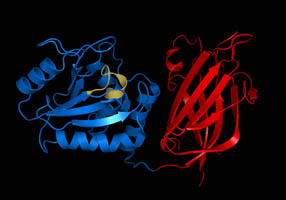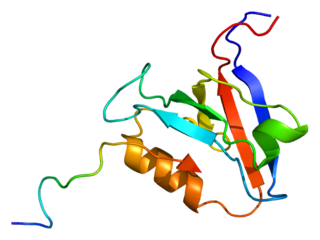
Phosphatase and tensin homolog (PTEN) is a phosphatase in humans and is encoded by the PTEN gene. Mutations of this gene are a step in the development of many cancers, specifically glioblastoma, lung cancer, breast cancer, and prostate cancer. Genes corresponding to PTEN (orthologs) have been identified in most mammals for which complete genome data are available.

Serine/threonine-protein phosphatase 2A catalytic subunit alpha isoform is an enzyme that is encoded by the PPP2CA gene.

Cell division control protein 6 homolog is a protein that in humans is encoded by the CDC6 gene.

Serine/threonine-protein phosphatase 2A 65 kDa regulatory subunit A alpha isoform is an enzyme that in humans is encoded by the PPP2R1A gene. In the plant Arabidopsis thaliana a similar enzyme is encoded by the RCN1 gene (At1g25490).

Acidic leucine-rich nuclear phosphoprotein 32 family member A is a protein that in humans is encoded by the ANP32A gene. It is one of the targets of an oncomiR, MIRN21.

Serine/threonine-protein phosphatase 2A catalytic subunit beta isoform is an enzyme that in humans is encoded by the PPP2CB gene.

Serine/threonine-protein phosphatase 2A 55 kDa regulatory subunit B alpha isoform is an enzyme regulator that in humans is encoded by the PPP2R2A gene.

Serine/threonine-protein phosphatase 2A 56 kDa regulatory subunit gamma isoform is an enzyme that in humans is encoded by the PPP2R5C gene.

The enzyme protein-glutamate methylesterase (EC 3.1.1.61) catalyzes the reaction

Tyrosine-protein phosphatase non-receptor type 13 is an enzyme that in humans is encoded by the PTPN13 gene.

Serine/threonine-protein phosphatase 2A regulatory subunit B is an enzyme that in humans is encoded by the PPP2R4 gene.

Serine/threonine-protein kinase Nek2 is an enzyme that in humans is encoded by the NEK2 gene.

Serine/threonine-protein phosphatase 2A 65 kDa regulatory subunit A beta isoform is an enzyme that in humans is encoded by the PPP2R1B gene.

Serine/threonine-protein phosphatase 2A regulatory subunit B'' subunit alpha is an enzyme that in humans is encoded by the PPP2R3A gene. Protein phosphatase 2 is one of the four major Ser/Thr phosphatases and is implicated in the negative control of cell growth and division. Protein phosphatase 2 holoenzymes are heterotrimeric proteins composed of a structural subunit A, a catalytic subunit C, and a regulatory subunit B. The regulatory subunit is encoded by a diverse set of genes that have been grouped into the B/PR55, B'/PR61, and B''/PR72 families. These different regulatory subunits confer distinct enzymatic specificities and intracellular localizations to the holozenzyme. The product of this gene belongs to the B'' family. The B'' family has been further divided into subfamilies. The product of this gene belongs to the alpha subfamily of regulatory subunit B''. Alternative splicing results in multiple transcript variants encoding different isoforms.

Tyrosine-protein phosphatase non-receptor type 14 is an enzyme that in humans is encoded by the PTPN14 gene.

Acidic leucine-rich nuclear phosphoprotein 32 family member E is a protein that in humans is encoded by the ANP32E gene. The ANP32E gene is located on chromosome 1q22. In mammalian cells, ANP32E has been shown to be an H2A.Z chaperone capable of promoting the removal of H2A.Z from chromatin. In brain tissue, ANP32E together with Cpd1 regulate protein phosphatase 2A activity at synapses during synaptogenesis and has been observed to form a complex with ANP32A and SET that stabilizes short-lived mRNAs containing AU-rich elements, as well as having acetyltransferase inhibitory activity and having a role in chromatin remodeling and transcriptional regulation.

Protein phosphatase 2 (PP2), also known as PP2A, is an enzyme that in humans is encoded by the PPP2CA gene. The PP2A heterotrimeric protein phosphatase is ubiquitously expressed, accounting for a large fraction of phosphatase activity in eukaryotic cells. Its serine/threonine phosphatase activity has a broad substrate specificity and diverse cellular functions. Among the targets of PP2A are proteins of oncogenic signaling cascades, such as Raf, MEK, and AKT, where PP2A may act as a tumor suppressor.

Protein phosphatase 1 (PP1) belongs to a certain class of phosphatases known as protein serine/threonine phosphatases. This type of phosphatase includes metal-dependent protein phosphatases (PPMs) and aspartate-based phosphatases. PP1 has been found to be important in the control of glycogen metabolism, muscle contraction, cell progression, neuronal activities, splicing of RNA, mitosis, cell division, apoptosis, protein synthesis, and regulation of membrane receptors and channels.
(phosphatase 2A protein)-leucine-carboxy methyltransferase is an enzyme with systematic name S-adenosyl-L-methionine:(phosphatase 2A protein)-leucine O-methyltransferase. This enzyme catalyses the following chemical reaction
Protein methylation is a type of post-translational modification featuring the addition of methyl groups to proteins. It can occur on the nitrogen-containing side-chains of arginine and lysine, but also at the amino- and carboxy-termini of a number of different proteins. In biology, methyltransferases catalyze the methylation process, activated primarily by S-adenosylmethionine. Protein methylation has been most studied in histones, where the transfer of methyl groups from S-adenosyl methionine is catalyzed by histone methyltransferases. Histones that are methylated on certain residues can act epigenetically to repress or activate gene expression.


















